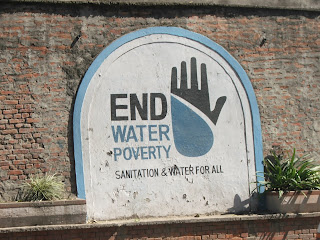Nepal is a land-locked country bordering India on three sides and bordering China (and Tibet) across the Himalaya Mountains on its northern edge. Recently emerging from a decade long civil war between government forces and Maoist insurgents, Nepal hangs in the balance of a new and fragile political identity. We did see the Maoist becoming more active while we were there. The Maoist were blockading key institutions like the airport or government buildings in Kathmandu. The streets were filled with Nepali gov. troops to deter the Maoists.Though Nepal has ended a 240-year old monarchy by declaring itself a Republic, peace is difficult to achieve as fighting continues within and between ethnic militant groups. Despite immense natural resources and an economy largely based on agriculture, tourism and textiles, Nepal is one of the poorest countries in the world, ranked 145 out of 179 countries, according to the Human Development Index (HDI)-( in between Kenya and Sudan).
Nepal’s 29.5 million people find themselves divided in vast and varied ways. There are multiple dialects and languages spoken by several people groups throughout the country, and Nepali is only spoken by roughly half of the population. Nepal is a predominately Hindu society, and much social stratification is employed by the caste system, resulting in a culture of discrimination both towards Dalits (untouchables) and women (more on this in next blog entry). Until May 2006 Nepal had officially been a Hindu state but in that month was declared a secular state. Around 80% of the population are Hindu, with around 10% being Buddhist, around 4% Muslim and the rest a variety of other religions, including as many as 800,000 Christians.
Nepal’s hills and plains (Terai) make up approximately 85% of its geography and give way to the magnificence of the Himalayas, covering the remaining 15% of the country, and crowned by Mount Everest. It is especially within these remote hill and mountain areas where one’s life is defined by hardship and few opportunities. We saw this grinding poverty and hardship with our own eyes in Kathmandu and the remote villages.
We saw many things in the first few days in the city before heading to the remote villages of Nepal. Smog did abound. On most occasions we had to walk the streets with bandanas over our mouths because of the pollution. Most people wear masks to help with their breathing here. Yet we did find those glimpses of hope and beauty through the smog and diesel fumes. Here are a few of the realities of Kathmandu...
This sign is more significant than most people could imagine...only 7% of Kathmandu's water is treated, the rest is pumped into the river

The River

The Central Market

Market Masks

Overlooking into the Market

Dal Bat (the Nepali national food)-Comprised of rice and lentils and sides of spicy sauces and curry-had this more than we can count-we loved it after having it in the first week we were in Nepal and then by the second and third were sick of it for every meal of breakfast, lunch and dinner!!

Temples of Kathmandu



The World's Largest Sand Art Mural (in the only mall of Nepal)

Constant Traffic

Street view

Monkeys in the middle of the city, with just a tree and trash, they too suffer from poverty and the smog

Buddhists prayer flags

More Temples



Power issues abound as you can imagine...


And More Temples




